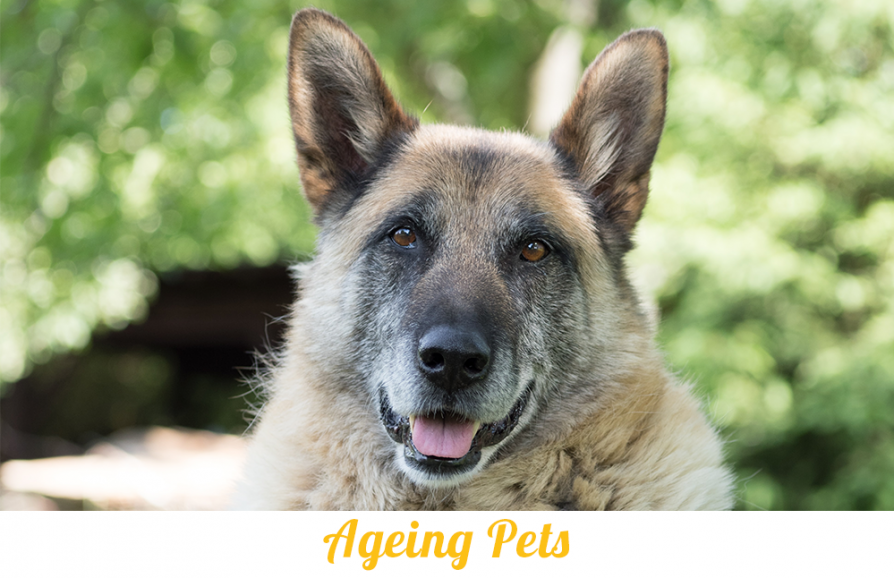Ageing in pets: Behavioural changes
- July 12th 2021

As our beloved Kafka grows older, we’ve been forced to confront the many changes that come with ageing in pets. The process is gradual, but the changes do sneak up on you and can be surprising if you don’t know what to look out for.
Therefore, welcome to our new The Pet Project series! We’ll be covering
a range of topics related to ageing in pets, starting with the behavioural
changes you can expect to see in your beloved dogs. Some of these will be
recognizable if you’ve ever watched a human being grow old, while some might
catch you by surprise. Either way, here’s a list of changes you can expect to
start seeing as soon as your dog becomes “senior”.
First things first—what’s a senior dog?
Excellent question! There is, actually, no one age at which a dog is
considered “senior”. Usually, it tends to be categorized by size and breed.
Large breed dogs age faster, so they’re considered “senior” at around 6 or 7
years of age, while small breed dogs are only considered elderly when they’re
10 or 12 years old. Predictably, dogs of middle size fall in the middle, and
are generally considered senior when they are 8 or 9 years old.
Cats are considered elderly when they’re about 11 years of age—so their
old age is generally between 11 and 14 years of age, based on the average cat
life span.
Now that you’re equipped with the definition of “senior” and know where
your pet falls on the seniority range, what can you expect in terms of changes
in pet behaviour?
Loss of judgement regarding space and
positioning
Just like humans, pets have a keen awareness of their spatial
surroundings. It allows them to move through rooms like the hallroom without
bumping into the three side tables and four large armchairs you’ve placed
there, as well as navigate your bookshelves and that elaborate showpiece. For
cats, it also helps with their incredible jumping and balancing skills. The
internet is full of pictures of cats balancing at the top of doors and leaping from
one piece of furniture to another—now you know where they get it from.
But as your pets get older, this quality starts to get a bit rusty. Pets
tend to get disoriented about where they are spatially, which means older
dogs—and cats, yes—bump into a lot of things and are generally rockier on their
four paws. You may also find them growing disoriented in new settings, where
they have to make a mental map of the room from scratch. As they get older,
this confusion may seep into familiar settings as well.
Changes in social behaviours
As your dog grows older, they tend to change in social behaviour as
well. Some of them tend to get grumpier, and less tolerant of petting and
cuddles that they don’t like. Some of them growl or snap, although this
behaviour can be trained or disciplined out of them. Some dogs also retreat a
bit from the world—they aren’t that interested in attention or play. They just
want to be fed and left alone.
Of course, these changes are not set in stone. There are plenty of dogs
who, as they grow older, get cuddlier and perhaps a bit more clingy. Several of
them grow upset if you leave them alone, even if you’re just off to the
bathroom or popping into the kitchen to get more tea. Abandoning them for a few
hours may lead to anxiety or panic. It all depends on the temperament of your
dog. Some dogs also get clingier when they begin to lose their hearing and
eyesight. Not being able to see you or hear you can be destabilising for them,
and having you near eases their discomfort.
Older dogs generally are less keen on socialising with new pets and
meeting other dogs. They tend to like being left alone, so a doggy play date
may not be their idea of fun anymore.
Sleep cycles
Sleep cycles can also be affected in elderly cats and dogs. They may
sleep more during the day and wake up more during the night. They may also
suffer from a fitful sleep cycle, where they keep awaking every few hours. Low
sleep can mean they’re generally lethargic and not keen to exercise or to play.
New patterns of acting
Senior dogs can also develop strange behaviour patterns. For instance,
they can become fixated with the idea of staring at a single spot. We know a senior
dog—about to turn 10 years old this month!—who usually greets company with a
few sniffs and then settles down to stare intensely at the wall, his back to
us. Others tend to wander around in aimless patterns, almost like an old person
moving around the house, convinced they’ve forgotten something but with no
memory of what. Some of them start vocalising more, but with no indication of
what they are barking or growling for.
Loss of abilities
No senior dog can do all the things they could in their youth. This
often means they can no longer navigate over obstacles that they’ve lived with
for several years. Your senior dogs will now have problems with the stairs,
with raising themselves on their hind legs to greet you, with climbing on the
sofa so you can cuddle—even with moving
around that large armchair,
simply because it looks too large and imposing to tackle.
Now that their bodies and minds are changing, it’s a whole new world for them—and they may need your help navigating it.
Comments
No posts found
